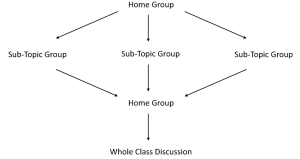6 Jigsaw Activity
What are jigsaw activities?
A jigsaw activity is a cooperative learning technique that can be used when there are multiple different concepts to be learned. Each student becomes responsible for teaching one part of the content to the rest of the students in their group.
How can you use jigsaw activities in your course?
Start a jigsaw activity by introducing the main topic for the lesson and the sub-topics that make up the lesson. For example, the main topic for the lesson could be “acid base theories” and the sub-topics could be “Arrhenius Acid and Base Theory,” “Bronsted-Lowry Acid and Base Theory,” and “Lewis Acid and Base Theory.”
Then, separate students into small groups with at least one student for each of the sub-topics. In these home groups, students should share their initial understanding of the topic and then decide who in the group is going to become the expert on each of the sub-topics with at least one student from each group becoming an expert on each of the sub-topics.
Students will then split up and meet with the other students that are becoming experts on the same sub-topics. Within these groups, they discuss the material, answer questions, and ensure everyone understands the topic. Their goal is to learn as much as they can on the topic as they will be responsible for teaching that content to their home group.
Finally, students return to their original home group and teach their sub-topic to the others in their group. Their goal is to make sure everyone in their group understands the material.
This can continue by having a whole class discussion and an informal assessment on the material.

Figure comes from Tarhan, L., and Sesen, B.A. (2012) Jigsaw cooperative learning: Acid-base theories. Chemistry Education Research and Practice, 13, 307-313.
What results can you expect from incorporating jigsaw activities into your course?
Research on jigsaw activities suggests that it helps students gain deeper understandings of course materials with fewer misconceptions. Students that participate in jigsaw activities do better on exams. Students also generally have a positive attitutde towards jigsaw activities, can support belonging and interaction with other students, and can help build interest in topics.
Who can help if you’re interested in incorporating jigsaw activities into your course?
For more information, please consult the following resources:
Teaching chemical bonding through jigsaw cooperative learning
Jigsaw cooperative learning: Acid-base theories
If you would like to explore how you could use this in your course, please reach out to the Center for Teaching for assistance and guidance on how best to implement these activities.
